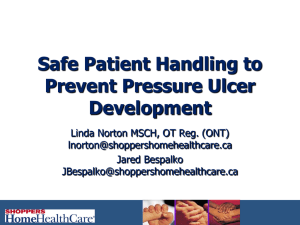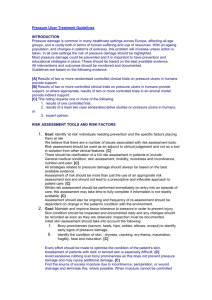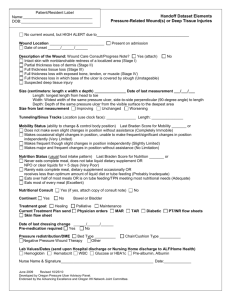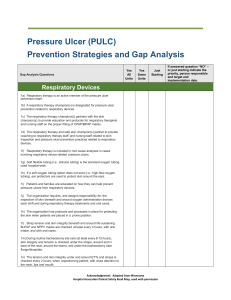New Turning and Positioning System Facilitates Patient
advertisement
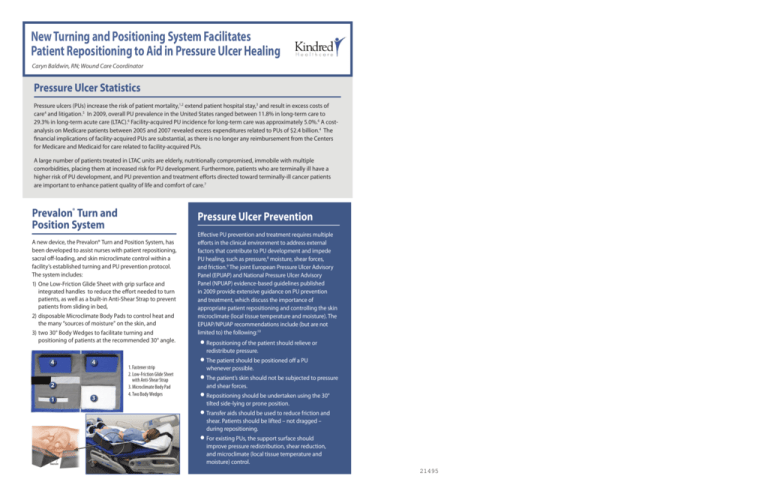
New Turning and Positioning System Facilitates Patient Repositioning to Aid in Pressure Ulcer Healing Caryn Baldwin, RN; Wound Care Coordinator Pressure Ulcer Statistics Pressure ulcers (PUs) increase the risk of patient mortality,1,2 extend patient hospital stay,3 and result in excess costs of care4 and litigation.5 In 2009, overall PU prevalence in the United States ranged between 11.8% in long-term care to 29.3% in long-term acute care (LTAC).6 Facility-acquired PU incidence for long-term care was approximately 5.0%.6 A costanalysis on Medicare patients between 2005 and 2007 revealed excess expenditures related to PUs of $2.4 billion.4 The financial implications of facility-acquired PUs are substantial, as there is no longer any reimbursement from the Centers for Medicare and Medicaid for care related to facility-acquired PUs. A large number of patients treated in LTAC units are elderly, nutritionally compromised, immobile with multiple comorbidities, placing them at increased risk for PU development. Furthermore, patients who are terminally ill have a higher risk of PU development, and PU prevention and treatment efforts directed toward terminally-ill cancer patients are important to enhance patient quality of life and comfort of care.7 Prevalon® Turn and Position System Pressure Ulcer Prevention A new device, the Prevalon® Turn and Position System, has been developed to assist nurses with patient repositioning, sacral off-loading, and skin microclimate control within a facility’s established turning and PU prevention protocol. The system includes: 1) One Low-Friction Glide Sheet with grip surface and integrated handles to reduce the effort needed to turn patients, as well as a built-in Anti-Shear Strap to prevent patients from sliding in bed, 2)disposable Microclimate Body Pads to control heat and the many “sources of moisture” on the skin, and 3)two 30° Body Wedges to facilitate turning and positioning of patients at the recommended 30° angle. 4 4 2 1 3 1. Fastener strip 2. Low-Friction Glide Sheet with Anti-Shear Strap 3. Microclimate Body Pad 4. Two Body Wedges Effective PU prevention and treatment requires multiple efforts in the clinical environment to address external factors that contribute to PU development and impede PU healing, such as pressure,8 moisture, shear forces, and friction.9 The joint European Pressure Ulcer Advisory Panel (EPUAP) and National Pressure Ulcer Advisory Panel (NPUAP) evidence-based guidelines published in 2009 provide extensive guidance on PU prevention and treatment, which discuss the importance of appropriate patient repositioning and controlling the skin microclimate (local tissue temperature and moisture). The EPUAP/NPUAP recommendations include (but are not limited to) the following:10 lRepositioning of the patient should relieve or redistribute pressure. lThe patient should be positioned off a PU whenever possible. lThe patient’s skin should not be subjected to pressure and shear forces. lRepositioning should be undertaken using the 30° tilted side-lying or prone position. lTransfer aids should be used to reduce friction and shear. Patients should be lifted – not dragged – during repositioning. lFor existing PUs, the support surface should improve pressure redistribution, shear reduction, and microclimate (local tissue temperature and moisture) control. 21495 CASE HISTORY Patient description: The patient was a 91-year-old male with an admitting diagnosis of aspiration pneumonia and past medical history significant for prostate cancer with metastasis to the bone. Patient Satisfaction The patient reported satisfaction with the Turn and Position System, due to his substantial decrease in pain with repositioning (8-9 out of 10 before Turn and Position System compared with 0 out of 10 with Turn and Position System). Braden score on admission: 15 (high risk secondary to activity, mobility, friction/sheer and nutritional status) Laboratories on admission: Pre- albumin 17, albumin 3.1 Skin status on admission to hospital: The patient has a stage II sacral PU measuring 3 x1.5 x 0.1cm, 0% epithelial tissue, and mild incontinence-associated dermatitis (IAD) treated with moisture barrier with zinc oxide. Continence status: The patient was incontinent of both urine and stool, with external male catheter on admission, and placement of Foley catheter during hospitalization. Admission to long-term acute care (LTAC): The patient was admitted to the LTAC primarily for intravenous antibiotics and wound care. He was also treated by speech therapy, physical therapy, and occupational therapy. Pain on admission to LTAC: The patient’s pain was assessed q2h on a scale of 0 to 10, with 0 being the absence of pain and 10 being severe pain. On admission, the patient complained of significant pain in his back, reporting pain levels of 8 to 9 with repositioning, and consistently requested p.r.n. pain medication. The patient required IV Morphine for pain control 2 -3 times daily initially. Pain medication regimen on admission to LTAC: The patient had a physician order for Darvocet p.o. b.i.d. p.r.n. or morphine IV q8h p.r.n. Initial wound care consultation: 10/17/2010 Prevalon® Turn and Position System initiated: 10/22/2010 Figure 1. Stage II pressure ulcer noted on sacrum with mild IAD. Pain on discharge from LTAC: After the Turn and Position System was initiated and utilized, the patient reported a pain level of 0 consistently for the last 5 days of his LTAC stay. The last dose of p.r.n. pain medication was given on 10/28/2010. Skin status on discharge: At the time of discharge from the LTAC, the patient’s wound had 70% epithelial tissue and IAD had resolved. Length of stay: The patient’s length of stay at the LTAC was 19 days from 10/15/2010 to 11/02/2010 Wound care protocol The patient was treated for a stage II sacral PU which was present on admission. The wound care protocol consisted of: lSkin care with Remedy™ products consisting of cleansing foam, Calazime™ moisture barrier cream, and moisturizing lotion. lWound cleansed with normal saline. lWound dressed with Meplix® border changed every 3 days and p.r.n. lPatient placed on a low air loss support surface. lPatient repositioned with Prevalon® Turn and Position System q2h and as needed. Remedy™ and Calazime™ are trademarks of Medline Industries, Inc. Meplix® is a registered trademark of Mölnlycke Healthcare Figure 2. Resolution of IAD and improvement of stage II sacral PU noted. Caregiver Satisfaction All nurses who completed a caregiver survey (N=4) stated: The majority of caregivers stated: l The patient was more compliant with repositioning q2h and p.r.n. when the Turn and Position System was used (4 of 4) l Use of the Turn and Position System prevented unnecessary pressure, friction, and shear during patient repositioning (4 of 4) 1. They spent less time repositioning the patient with the Turn and Position System compared with time spent for “usual” repositioning without the system (3 of 4) 2. The Turn and Position System eased their usual physical efforts extended for patient repositioning (3 of 4) 3. They felt the design of the Turn and Position System helped maintain appropriate body mechanics with patient repositioning (3 of 4) 4. The Turn and Position System lessened the patient’s usual physical efforts extended for repositioning (3 of 4) 5. The Turn and Position System decreased patient pain associated with efforts of repositioning (3 of 4) 6. Use of the Turn and Position System helped them comply with a minimum of q2h and as needed patient repositioning (3 of 4) 7. The Turn and Position System prevented the patient from sliding down in bed (3 of 4) The patient’s niece, the primary caregiver at home, ensured the Turn and Position System was utilized appropriately q2h during the hospital stay. She was very satisfied with the product and requested the patient be discharged to home with the Turn and Position System to assist her with regular repositioning of the patient, and to ensure his level of comfort with repositioning was maintained. Clinical Implications References 1. Landi F, Onder G, Russo A, Bernabei R. Pressure ulcer and mortality in frail elderly people living in community. Arch Gerontol Geriatr. 2007;44 Suppl 1:217-223. Reduction in pain during repositioning increases patient satisfaction. 2. Redelings MD, Lee NE, Sorvillo F. Pressure ulcers: more lethal than we thought? Adv Skin Wound Care. 2005;18(7):367-372. 3. Cuddigan JE, Ayello EA, Black J. Saving heels in critically ill patients. WCET Journal. 2008;28(2):2-8. 4. Increased patient tolerance of repositioning facilitates wound healing and wound prevention. HealthGrades Inc. The Sixth Annual HealthGrades patient Safety in American Hospitals Study. 2009. www. healthgrades.com/media/dms/pdf/PatientSafetyinAmericanHospitalsStudy2009.pdf. Accessed December 17, 2010. 5. Plawecki LH, Amrhein DW, Zortman T. Under pressure: nursing liability and skin breakdown in older patients. J Gerontol Nurs. 2010 Feb;36(2):23-5. doi: 10.3928/00989134-20100108-03. 6. VanGilder C, Amlung S, Harrison P, Meyer S. Results of the 2008 - 2009 international pressure ulcer prevalence survey and a 3-year, acute care, unit-specific analysis. Ostomy Wound Manage. 2009;55(11):39-45. 7. Hendrichova I, Castelli M, Mastroianni C, et al. Pressure ulcers in cancer palliative care patients. Palliat Med. 2010;24(7):669-673. 8. Bansal C, Scott R, Stewart D, Cockerell CJ. Decubitus ulcers: a review of the literature. Int J Dermatol. 2005;44(10):805-810. 9. Hanson D, Langemo DK, Anderson J, Thompson P, Hunter S. Friction and shear considerations in pressure ulcer development. Adv Skin Wound Care. 2010;23(1):21-24. Absorbent underpads facilitate resolution of IAD. Ease of use for caregivers increases compliance with patient repositioning. 10. European Pressure Ulcer Advisory Panel and National Pressure Ulcer Advisory Panel. Prevention and treatment of pressure ulcers: quick reference guide. National Pressure Ulcer Advisory Panel, Washington DC, 2009.

